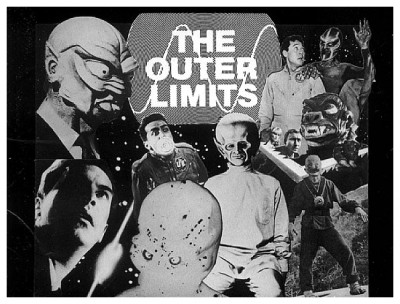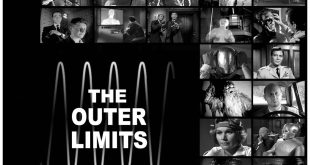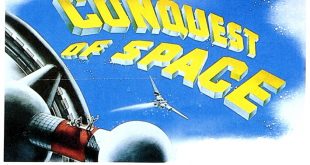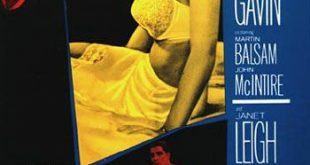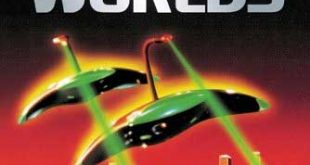 “There is nothing wrong with your television set. Do not attempt to adjust the picture. We are controlling transmission. We control the horizontal, we control the vertical. For the next hour, sit quietly and we will control what you see and hear. You are about to participate in a great adventure. You are about to experience the awe and mystery which reaches from the inner mind to…The Outer Limits.”
“There is nothing wrong with your television set. Do not attempt to adjust the picture. We are controlling transmission. We control the horizontal, we control the vertical. For the next hour, sit quietly and we will control what you see and hear. You are about to participate in a great adventure. You are about to experience the awe and mystery which reaches from the inner mind to…The Outer Limits.”
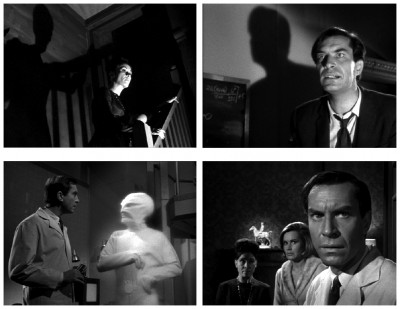 #20 THE BELLERO SHIELD directed by John Brahm from a script by Joseph Stefano, Lou Morheim and Arthur Leo Zagat. Dedicated scientist Richard Bellero Junior (Martin Landau) is working on experiments involving sending laser beams into outer space. His father, Richard Bellero Senior (Neil Hamilton), believes his son isn’t strong enough to take over the Bellero business empire. Meanwhile, Richard’s wife Judith (Sally Kellerman) has more than enough ambition for the two of them. Due to a freak accident, Richard’s laser reels in a peaceful being (John Hoyt) from another dimension who carries a small device projects a shield that no force can penetrate. The alien wants to learn all about Earth and Richard cooperates, but Judith sees the alien and its shield device as a means to power. While Richard is away, Judith tricks the alien into deactivating his shield then shoots the alien to prevent him from leaving. She removes the hand-held device but fails to notice it was connected to a vein of the alien, whose bodily fluid is the key to operating the device. Thus begins Judith’s downfall. During a demonstration she raises the shield but unable to take it down, becoming trapped inside it. The alien, believed dead, is revived and comes to her rescue to lower the shield before dying, by using its own blood to open it. Judith is driven insane with the guilt of killing the alien that only thought of helping her, and believes herself to be still trapped within the shield as the episode ends. Joseph Stefano and Lou Morheim wrote a captivating tale that encompasses a wide spectrum of behaviour: wonder, betrayal, innocence, deception and poetic justice. It also features some of the best dialogue in the show’s history, fine performances from all involved and a riveting score from Dominic Frontiere. The plot of an easily controlled man and his ambitious wife has parallels with William Shakespeare‘s Macbeth, and the analogy is made clear with the line, “Lust is what becomes of an aspiration when it is allowed to grow and become ambition.” Many UFO skeptics point to this episode to explain the grey aliens seen by Betty Hill and Barney Hill during their famous abduction in 1961. Under hypnosis, Barney’s memories were influenced by The Bellero Shield, which was broadcast only twelve days before Barney’s first hypnotic session. The episode features an extraterrestrial with large ‘wraparound’ eyes who says, “In all the universes, in all the unities beyond the universes, all who have eyes have eyes that speak.” When Betty was asked about The Outer Limits, she insisted she had never heard of the show.
#20 THE BELLERO SHIELD directed by John Brahm from a script by Joseph Stefano, Lou Morheim and Arthur Leo Zagat. Dedicated scientist Richard Bellero Junior (Martin Landau) is working on experiments involving sending laser beams into outer space. His father, Richard Bellero Senior (Neil Hamilton), believes his son isn’t strong enough to take over the Bellero business empire. Meanwhile, Richard’s wife Judith (Sally Kellerman) has more than enough ambition for the two of them. Due to a freak accident, Richard’s laser reels in a peaceful being (John Hoyt) from another dimension who carries a small device projects a shield that no force can penetrate. The alien wants to learn all about Earth and Richard cooperates, but Judith sees the alien and its shield device as a means to power. While Richard is away, Judith tricks the alien into deactivating his shield then shoots the alien to prevent him from leaving. She removes the hand-held device but fails to notice it was connected to a vein of the alien, whose bodily fluid is the key to operating the device. Thus begins Judith’s downfall. During a demonstration she raises the shield but unable to take it down, becoming trapped inside it. The alien, believed dead, is revived and comes to her rescue to lower the shield before dying, by using its own blood to open it. Judith is driven insane with the guilt of killing the alien that only thought of helping her, and believes herself to be still trapped within the shield as the episode ends. Joseph Stefano and Lou Morheim wrote a captivating tale that encompasses a wide spectrum of behaviour: wonder, betrayal, innocence, deception and poetic justice. It also features some of the best dialogue in the show’s history, fine performances from all involved and a riveting score from Dominic Frontiere. The plot of an easily controlled man and his ambitious wife has parallels with William Shakespeare‘s Macbeth, and the analogy is made clear with the line, “Lust is what becomes of an aspiration when it is allowed to grow and become ambition.” Many UFO skeptics point to this episode to explain the grey aliens seen by Betty Hill and Barney Hill during their famous abduction in 1961. Under hypnosis, Barney’s memories were influenced by The Bellero Shield, which was broadcast only twelve days before Barney’s first hypnotic session. The episode features an extraterrestrial with large ‘wraparound’ eyes who says, “In all the universes, in all the unities beyond the universes, all who have eyes have eyes that speak.” When Betty was asked about The Outer Limits, she insisted she had never heard of the show.
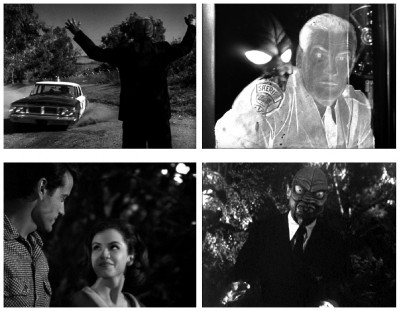 #21 THE CHILDREN OF SPIDER COUNTY directed by Leonard Horn from a script by Anthony Lawrence. Four young men with high IQs have mysteriously disappeared on the same day. Born and raised in Spider County, the prodigies share the same middle name of Eros, an obscure planet in the Krell galaxy orbiting the Orion constellation. A government agent (John Milford) is sent to find a fifth young man, Ethan Eros Wechsler (Lee Kinsolving), who has been arrested and charged for the murder of a young girl’s suitor after he telepathically ‘hears’ an ill-mannered remark made towards her. Because of his unique abilities and loner attitude, Ethan has been ostracised by the locals, thus compelling his alien ‘father’ (Kent Smith) to rescue him from his human captors and return him to Eros, together with his fellow prodigies, where they can be honoured and revered for their special gifts. Following numerous attempts at escape and recapture, Ethan is finally reunited with his ‘brothers’ and professes his love for the young girl, Anna (Bennye Gatteys). He refuses to return with his father to Eros, having enjoyed his life on Earth despite the prejudice and mistrust he has encountered. The father reluctantly agrees and, after Ethan convinces his brothers to remain on Earth with him, the alien patriarch departs without them. Scripted by a non-regular Outer Limits writer, the story has a ‘boy’s own’ feel with only one minor female character present. Instead of the oft-seen romance normally found in The Outer Limits, we get wonderfully filmed and scored chase scenes through the mist-covered forest and sound effects from War Of The Worlds (1953). These scenes provide a good break from the dialogue and the variety is most welcome. More entertainment comes from the rather goofy dialogue, mainly during the prison scene, that give the story a unique identity. Not all the talk is corny though – the theme about the need to dream is so true – imagine a world without dreamers? Many fans have found other meanings in the story, but you’d have to look hard to find these meanings in the episode itself. The idea of a twenty-something boy suddenly finding he has an alien father is compelling, one of the best to come out of this series. These themes play without the typical sixties-style space-age hardware or computers. Instead, it takes place mostly on a timeless farm or in the forest – a great looking episode that still holds up half a century later. Sadly, the talented actor playing Ethan (Lee Kinsolving) is no longer with us, passing away of mysterious health problems only ten years after this episode was broadcast, a sad turn of events that makes The Children Of Spider County his finest hour.
#21 THE CHILDREN OF SPIDER COUNTY directed by Leonard Horn from a script by Anthony Lawrence. Four young men with high IQs have mysteriously disappeared on the same day. Born and raised in Spider County, the prodigies share the same middle name of Eros, an obscure planet in the Krell galaxy orbiting the Orion constellation. A government agent (John Milford) is sent to find a fifth young man, Ethan Eros Wechsler (Lee Kinsolving), who has been arrested and charged for the murder of a young girl’s suitor after he telepathically ‘hears’ an ill-mannered remark made towards her. Because of his unique abilities and loner attitude, Ethan has been ostracised by the locals, thus compelling his alien ‘father’ (Kent Smith) to rescue him from his human captors and return him to Eros, together with his fellow prodigies, where they can be honoured and revered for their special gifts. Following numerous attempts at escape and recapture, Ethan is finally reunited with his ‘brothers’ and professes his love for the young girl, Anna (Bennye Gatteys). He refuses to return with his father to Eros, having enjoyed his life on Earth despite the prejudice and mistrust he has encountered. The father reluctantly agrees and, after Ethan convinces his brothers to remain on Earth with him, the alien patriarch departs without them. Scripted by a non-regular Outer Limits writer, the story has a ‘boy’s own’ feel with only one minor female character present. Instead of the oft-seen romance normally found in The Outer Limits, we get wonderfully filmed and scored chase scenes through the mist-covered forest and sound effects from War Of The Worlds (1953). These scenes provide a good break from the dialogue and the variety is most welcome. More entertainment comes from the rather goofy dialogue, mainly during the prison scene, that give the story a unique identity. Not all the talk is corny though – the theme about the need to dream is so true – imagine a world without dreamers? Many fans have found other meanings in the story, but you’d have to look hard to find these meanings in the episode itself. The idea of a twenty-something boy suddenly finding he has an alien father is compelling, one of the best to come out of this series. These themes play without the typical sixties-style space-age hardware or computers. Instead, it takes place mostly on a timeless farm or in the forest – a great looking episode that still holds up half a century later. Sadly, the talented actor playing Ethan (Lee Kinsolving) is no longer with us, passing away of mysterious health problems only ten years after this episode was broadcast, a sad turn of events that makes The Children Of Spider County his finest hour.
 #22 SPECIMEN UNKNOWN directed by Gerd Oswald from a script by Stephen Lord. Astronaut Howard (Dabney Coleman), one of a team of scientists, finds a strange mushroom-shaped organism clinging to the outside of their space station. Exposed to light and air inside, it grows into a beautiful flower, but has a deadly scent and an aggressive growth habit. Upon Howard’s discovery of the organism’s rapid metamorphosis, the flower emits a noxious gas that temporarily incapacitates him, after which he dies. When the other astronauts attempt to return to Earth for help, they bring the invasive new species along with them, but their superiors on Earth order the ship’s crew to remain in orbit until a method can be found to eliminate the threat. As the spacecraft runs out of fuel, the half-dead crew is forced to crash-land near the rocket base, where a team of scientists and military personnel immediately descend upon and surround the crash site in an attempt to contain the spread of the organism which, by now, has fully engulfed the interior of the ship and taken hold of the surrounding countryside. Continuing to spew their spores and spray their deadly gas, the plants scatter themselves across the land, while storm clouds form overhead. As all hope for survival is about to fade, the sky opens up and drenches the land with life-giving rain, killing the flowers until they eventually succumb to the effects of mother nature.
#22 SPECIMEN UNKNOWN directed by Gerd Oswald from a script by Stephen Lord. Astronaut Howard (Dabney Coleman), one of a team of scientists, finds a strange mushroom-shaped organism clinging to the outside of their space station. Exposed to light and air inside, it grows into a beautiful flower, but has a deadly scent and an aggressive growth habit. Upon Howard’s discovery of the organism’s rapid metamorphosis, the flower emits a noxious gas that temporarily incapacitates him, after which he dies. When the other astronauts attempt to return to Earth for help, they bring the invasive new species along with them, but their superiors on Earth order the ship’s crew to remain in orbit until a method can be found to eliminate the threat. As the spacecraft runs out of fuel, the half-dead crew is forced to crash-land near the rocket base, where a team of scientists and military personnel immediately descend upon and surround the crash site in an attempt to contain the spread of the organism which, by now, has fully engulfed the interior of the ship and taken hold of the surrounding countryside. Continuing to spew their spores and spray their deadly gas, the plants scatter themselves across the land, while storm clouds form overhead. As all hope for survival is about to fade, the sky opens up and drenches the land with life-giving rain, killing the flowers until they eventually succumb to the effects of mother nature.
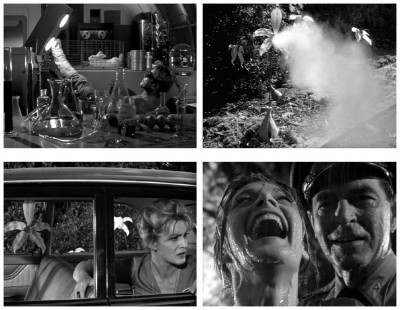 This was the highest Nielsen-rated episode in the first season of The Outer Limits, inspired by The Day Of The Triffids by John Wyndham, and the idea was utilised again in the Star Trek episode This Side Of Paradise. Projects Unlimited made 150 prop plants for the closing scenes, some of which were working models that fired aerosol mist and spores (actually Puffed Wheat breakfast cereal). The mock-up of the space shuttle was painted black to be re-used in The Twilight Zone episode Probe 7 Over And Out, and the Adonis space station is a leftover prop from the television series Men Into Space. When the episode was assembled, it ran only forty-five minutes. To extend the film, shots of the Adonis model hanging in space were lengthened and slow-motion was applied to the shots of astronaut Doweling (Richard Jaekel) repairing the Adonis shuttle. Leslie Stevens quickly wrote a prologue featuring astronaut Howard, Joseph Stefano wrote an unusually long Control Voice monologue concerning the history of the space program, and the opening teaser lasts nearly three minutes, all of which stretched the episode to the required running time.
This was the highest Nielsen-rated episode in the first season of The Outer Limits, inspired by The Day Of The Triffids by John Wyndham, and the idea was utilised again in the Star Trek episode This Side Of Paradise. Projects Unlimited made 150 prop plants for the closing scenes, some of which were working models that fired aerosol mist and spores (actually Puffed Wheat breakfast cereal). The mock-up of the space shuttle was painted black to be re-used in The Twilight Zone episode Probe 7 Over And Out, and the Adonis space station is a leftover prop from the television series Men Into Space. When the episode was assembled, it ran only forty-five minutes. To extend the film, shots of the Adonis model hanging in space were lengthened and slow-motion was applied to the shots of astronaut Doweling (Richard Jaekel) repairing the Adonis shuttle. Leslie Stevens quickly wrote a prologue featuring astronaut Howard, Joseph Stefano wrote an unusually long Control Voice monologue concerning the history of the space program, and the opening teaser lasts nearly three minutes, all of which stretched the episode to the required running time.
 #23 SECOND CHANCE directed by Paul Stanley from a script by Lou Morheim and Sonya Roberts. Disillusioned physicist Dave Crowell (Don Gordon) has found an undemanding temporary job – operating a space-flight simulator at an amusement park – to escape from his former Defense Department employer’s demands to develop weapons of mass destruction. However, an alien (Simon Oakland) from the planet Empyria stealthily modifies the attraction into an actual interplanetary spacecraft and, passing himself off as a roving sideshow, invites a group of misfits who refuse to confront the unpleasant realities of their own lives. The Empyrian offers the group a second chance to better themselves – an opportunity to colonise a small planet called Tythra. To turn this dream into a reality, each passenger must overcome their unwillingness to face their own true nature and to work as a team. As violence escalates between the distressed abductees and the flight crew, Crowell convinces the alien that the operation is doomed to fail, explaining that it’s against human nature to expect someone to accept their own shortcomings and admit their failures. Instead, he advises the alien to seek help directly from Earth’s governments to initialise a proper collaboration for the sake of each individual, by asking for volunteers to accompany them to Tythra. Approving of Crowell’s choice, the Empyrian turns the spaceship around to take the reluctant abductees back to Earth. There are many plot holes in this story, not least the fact that the alien is able to turn the carnival ride into a functional spaceship, but the performances by Simon Oakland and John McLiam (as R.J. Beasley) make for a very entertaining episode. Angela Clarke plays Mrs. Beasley while Yale Summers – later to star in Daktari – is on hand as the resident jock forced to show his mettle in the life-threatening kidnapping. Lou Morheim retained the basic plot in his rewrite of Sonya Roberts’ script but, where Roberts approached the plot with intelligence and humour, Morheim geared the story to be more conventional and threw out most of the emotional depth and humour. For instance, when the alien walks around handing out free tickets, he frightens everyone by suddenly appearing but, in the original script, the alien wears a sandwich board that says, “Greetings Earthmen, I Am From The Planet Empyria In Outer Space.” In another scene, the alien hypnotises Beasley into donning his safety belt but, in the original script, he achieves this by convincing Beasley to ‘pretend’ everything is real, threatening to shoot him with his ray gun if he doesn’t. Laughing, Beasley agrees to play along. Sonya Roberts had her name removed from the script and used the pseudonym Lin Dane.
#23 SECOND CHANCE directed by Paul Stanley from a script by Lou Morheim and Sonya Roberts. Disillusioned physicist Dave Crowell (Don Gordon) has found an undemanding temporary job – operating a space-flight simulator at an amusement park – to escape from his former Defense Department employer’s demands to develop weapons of mass destruction. However, an alien (Simon Oakland) from the planet Empyria stealthily modifies the attraction into an actual interplanetary spacecraft and, passing himself off as a roving sideshow, invites a group of misfits who refuse to confront the unpleasant realities of their own lives. The Empyrian offers the group a second chance to better themselves – an opportunity to colonise a small planet called Tythra. To turn this dream into a reality, each passenger must overcome their unwillingness to face their own true nature and to work as a team. As violence escalates between the distressed abductees and the flight crew, Crowell convinces the alien that the operation is doomed to fail, explaining that it’s against human nature to expect someone to accept their own shortcomings and admit their failures. Instead, he advises the alien to seek help directly from Earth’s governments to initialise a proper collaboration for the sake of each individual, by asking for volunteers to accompany them to Tythra. Approving of Crowell’s choice, the Empyrian turns the spaceship around to take the reluctant abductees back to Earth. There are many plot holes in this story, not least the fact that the alien is able to turn the carnival ride into a functional spaceship, but the performances by Simon Oakland and John McLiam (as R.J. Beasley) make for a very entertaining episode. Angela Clarke plays Mrs. Beasley while Yale Summers – later to star in Daktari – is on hand as the resident jock forced to show his mettle in the life-threatening kidnapping. Lou Morheim retained the basic plot in his rewrite of Sonya Roberts’ script but, where Roberts approached the plot with intelligence and humour, Morheim geared the story to be more conventional and threw out most of the emotional depth and humour. For instance, when the alien walks around handing out free tickets, he frightens everyone by suddenly appearing but, in the original script, the alien wears a sandwich board that says, “Greetings Earthmen, I Am From The Planet Empyria In Outer Space.” In another scene, the alien hypnotises Beasley into donning his safety belt but, in the original script, he achieves this by convincing Beasley to ‘pretend’ everything is real, threatening to shoot him with his ray gun if he doesn’t. Laughing, Beasley agrees to play along. Sonya Roberts had her name removed from the script and used the pseudonym Lin Dane.
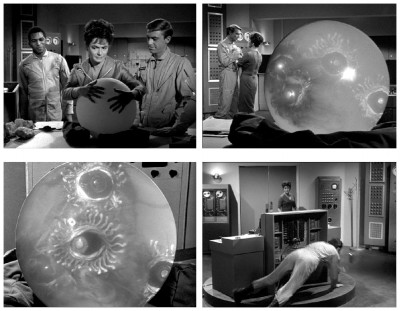 #24 MOONSTONE directed by Robert Florey from a script by William Bast, Lou Morheim and Joseph Stefano. On a moonbase in the near future, there is some friction among the staff caused by disgruntled Major Anderson (Tim O’Connor). During the Korean War, the General (Alex Nicol) who is now in charge of the moonbase had made a command decision to abandon a village to the Chinese, who destroyed it. The Major’s friend Professor Brice (Ruth Roman) learns about what happened, creating tension between her and the General. Meanwhile, scientists discover a perfectly round orb buried beneath the surface of the Moon, the repository of five benevolent alien intelligences fleeing tyranny in their own system. The beings inform the startled scientists that they are the greatest minds in the galaxy, having escaped their home planet Grippia to prevent their advanced knowledge from being used to conquer the universe. They were forced to land on the Moon due to a lack of sustainable energy, with our sun being too weak to provide them with enough power to continue their journey. The scientists offer the aliens sanctuary while they attempt to re-energise and, in exchange, they begin to record their combined wisdom on the base computers to preserve it before they are captured. When the tyrants arrive in pursuit, the researchers have to decide how much they should risk in the gathering of knowledge. The General is once again faced with a decision much like the one he’d faced in Korea: Do you sacrifice some in order that many will survive, even if it’s morally wrong? After one of the scientists dies when trying to defend them, the aliens convince the scientists to release them to the Tyrants to prevent their imminent destruction. This act of compassion and sacrifice in the face of certain death is reflected by the aliens as they self-destruct before being taken aboard the Tyrants’ craft, thus denying them the knowledge that they were so desperately seeking. Despite being a rather unsubtle episode, it is nevertheless an interesting one definitely worth watching and, although the aliens look pretty weird, the idea of completely non-humanoid intelligent aliens was pretty innovative at the time. William Bast’s original script contained many spectacular action scenes, most of which were either simplified or not done at all for logistical and budgetary reasons. The lunar landscape was constructed by Jack Poplin and his team and the moon backdrops were from MGM, the jagged mountains and rock columns were placed so as to hide the gaps in these backdrops. The moon surface itself was a ten-centimetre-deep layer of sand that had been dyed different colours to give the moonscape different gradations of tone when filmed in black and white. Paintings by astronomical artist Chesley Bonestell were used for sequences of the ‘moonstone’ moving over the lunar surface, and the Grippians were designed at Projects Unlimited by father-and-son team Marcel Delgado and Victor Delgado. The eyes of the aliens were actually ping pong balls on sticks dressed-up with added tendrils, filmed in a water tank so that their ‘hair’ would drift about as they swayed and moved. Vintage filmmaker Robert Florey directed more than fifty films, the most famous being The Cocoanuts (1929) starring the Marx Brothers, and Murders In The Rue Morgue (1932) starring Bela Lugosi. Florey was widely acclaimed to be the best director working in major studio B-grade films during the forties.
#24 MOONSTONE directed by Robert Florey from a script by William Bast, Lou Morheim and Joseph Stefano. On a moonbase in the near future, there is some friction among the staff caused by disgruntled Major Anderson (Tim O’Connor). During the Korean War, the General (Alex Nicol) who is now in charge of the moonbase had made a command decision to abandon a village to the Chinese, who destroyed it. The Major’s friend Professor Brice (Ruth Roman) learns about what happened, creating tension between her and the General. Meanwhile, scientists discover a perfectly round orb buried beneath the surface of the Moon, the repository of five benevolent alien intelligences fleeing tyranny in their own system. The beings inform the startled scientists that they are the greatest minds in the galaxy, having escaped their home planet Grippia to prevent their advanced knowledge from being used to conquer the universe. They were forced to land on the Moon due to a lack of sustainable energy, with our sun being too weak to provide them with enough power to continue their journey. The scientists offer the aliens sanctuary while they attempt to re-energise and, in exchange, they begin to record their combined wisdom on the base computers to preserve it before they are captured. When the tyrants arrive in pursuit, the researchers have to decide how much they should risk in the gathering of knowledge. The General is once again faced with a decision much like the one he’d faced in Korea: Do you sacrifice some in order that many will survive, even if it’s morally wrong? After one of the scientists dies when trying to defend them, the aliens convince the scientists to release them to the Tyrants to prevent their imminent destruction. This act of compassion and sacrifice in the face of certain death is reflected by the aliens as they self-destruct before being taken aboard the Tyrants’ craft, thus denying them the knowledge that they were so desperately seeking. Despite being a rather unsubtle episode, it is nevertheless an interesting one definitely worth watching and, although the aliens look pretty weird, the idea of completely non-humanoid intelligent aliens was pretty innovative at the time. William Bast’s original script contained many spectacular action scenes, most of which were either simplified or not done at all for logistical and budgetary reasons. The lunar landscape was constructed by Jack Poplin and his team and the moon backdrops were from MGM, the jagged mountains and rock columns were placed so as to hide the gaps in these backdrops. The moon surface itself was a ten-centimetre-deep layer of sand that had been dyed different colours to give the moonscape different gradations of tone when filmed in black and white. Paintings by astronomical artist Chesley Bonestell were used for sequences of the ‘moonstone’ moving over the lunar surface, and the Grippians were designed at Projects Unlimited by father-and-son team Marcel Delgado and Victor Delgado. The eyes of the aliens were actually ping pong balls on sticks dressed-up with added tendrils, filmed in a water tank so that their ‘hair’ would drift about as they swayed and moved. Vintage filmmaker Robert Florey directed more than fifty films, the most famous being The Cocoanuts (1929) starring the Marx Brothers, and Murders In The Rue Morgue (1932) starring Bela Lugosi. Florey was widely acclaimed to be the best director working in major studio B-grade films during the forties.
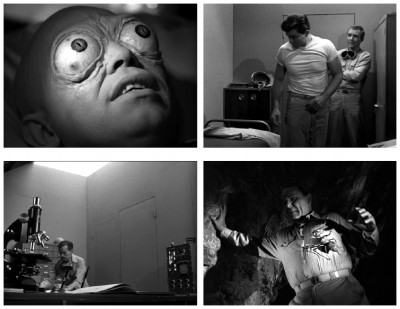 #25 THE MUTANT directed by Alan Crosland Junior from a script by Allan Balter, Robert Mintz and Jerome Thomas. A scientist named Evan Marshall (Larry Pennell) is sent to the planet Annex One to investigate the death of one of a group of Earth colonists who are testing to see if the planet is suitable for habitation. The entire planet is plagued by radioactive dust storms and in constant sunlight due to its two suns. The colonists, including Marshall’s ex-girlfriend Julie (Betsy Jones-Moreland), behave strangely and are particularly nervous around Reese Fowler (Warren Oates), who wears his polarised goggles at all times. Marshall is led to a remote cave by Julie where she explains that they live in fear of Reese, who developed superhuman abilities when he was accidentally exposed to the planet’s radioactive rainfall, which results in telekinesis, hair loss and the development of large protruding eyes. Reese knows he can never return to Earth and has been holding the others captive, threatening to kill them if they reveal the secret of his plight. Marshall must somehow overcome a man who can read minds and kill with a touch. To prevent Reese from knowing his plans, Marshall is given a post-hypnotic suggestion to forget what he has learned then – provided with a code-word to recall the events – inform his superiors on his return. In an unfortunate twist of fate, Reese discovers the deception and pursues Marshall and Julie into the cave intending to destroy them both. However, due to his sensitivity to darkness, Reese dies from intense pain while trying to absorb the dim glow of a candle’s flame into his light-starved eyes. While not nearly as frightening as when originally broadcast, this story still has plenty of punch and remains very eerie and wholly chilling. Warren Oates is virtually unrecognisable as the human scientist-turned-mutant with a Napoleon complex, but gives a fine performance nonetheless. Arguably, the premise was rehashed two years later in the second Star Trek pilot Where No Man Has Gone Before, less hideous and frightening, but the mutated crew member is just as malicious.
#25 THE MUTANT directed by Alan Crosland Junior from a script by Allan Balter, Robert Mintz and Jerome Thomas. A scientist named Evan Marshall (Larry Pennell) is sent to the planet Annex One to investigate the death of one of a group of Earth colonists who are testing to see if the planet is suitable for habitation. The entire planet is plagued by radioactive dust storms and in constant sunlight due to its two suns. The colonists, including Marshall’s ex-girlfriend Julie (Betsy Jones-Moreland), behave strangely and are particularly nervous around Reese Fowler (Warren Oates), who wears his polarised goggles at all times. Marshall is led to a remote cave by Julie where she explains that they live in fear of Reese, who developed superhuman abilities when he was accidentally exposed to the planet’s radioactive rainfall, which results in telekinesis, hair loss and the development of large protruding eyes. Reese knows he can never return to Earth and has been holding the others captive, threatening to kill them if they reveal the secret of his plight. Marshall must somehow overcome a man who can read minds and kill with a touch. To prevent Reese from knowing his plans, Marshall is given a post-hypnotic suggestion to forget what he has learned then – provided with a code-word to recall the events – inform his superiors on his return. In an unfortunate twist of fate, Reese discovers the deception and pursues Marshall and Julie into the cave intending to destroy them both. However, due to his sensitivity to darkness, Reese dies from intense pain while trying to absorb the dim glow of a candle’s flame into his light-starved eyes. While not nearly as frightening as when originally broadcast, this story still has plenty of punch and remains very eerie and wholly chilling. Warren Oates is virtually unrecognisable as the human scientist-turned-mutant with a Napoleon complex, but gives a fine performance nonetheless. Arguably, the premise was rehashed two years later in the second Star Trek pilot Where No Man Has Gone Before, less hideous and frightening, but the mutated crew member is just as malicious.
 #26 THE GUESTS directed by Paul Stanley from a script by Donald S. Sanford. A young drifter named Wade Norton (Geoffrey Horne) finds an old man (Burt Mustin) dying by the side of a remote country road. He picks up the man’s pocket watch, which contains a photo of a young woman. Seeking help, he enters a large house on a hill, whose inhabitants are surprisingly unhelpful but curious about the age of the old man he found. With the exception of a soulful young woman named Theresa (Luana Anders), whose photo is in the watch, everyone seems mean-spirited and disinterested. Trying to leave through the front door, Norton is forced backward and upstairs by a mysterious compulsion to discover that the house is actually the lair of an amorphous gelatinous alien being who is keeping the group of humans suspended in time until it can comprehend the disposition of humanity. It interrogates him then returns him to the group residing in the house where he is to learn the reason for their captivity. Theresa, knowing Wade’s potential fate, leads him to escape, but she refuses to leave with him, so Wade chooses to remain despite the warnings. She insists, and finally agrees to leave with him but, after they go through the gate, she withers and turn to dust. The observing alien has at last found the factors missing in its equation: love and self-sacrifice. Releasing Wade, who has discovered in himself hope, it deconstructs the house and destroys its tenants. The house returns momentarily to its true appearance, that of a large rock shaped like an enormous brain, and then disappears. Screenwriter Donald S. Sanford was hired by Lou Morheim on the strength of his work on the Boris Karloff anthology series Thriller, for which he had scripted fifteen episodes including The Incredible Doctor Markesan and The Cheaters, because Joseph Stefano was looking for material with an emphasis on the Gothic to provide director Curtis Harrington with an Outer Limits episode. A script by Charles Beaumont was given to Sanford for revision but, when Sanford came up with his own plot, Harrington backed out and Paul Stanley directed instead. Sanford’s script required so little revision that Stefano neglected to add the customary Control Voice speeches, so this episode has no opening or closing narration. Like most episodes of The Outer Limits, there is a profound philosophical message at work behind the monsters and the melodrama. In this case they seemed to be working toward a Groundhog Day (1993)-style allegory about living a meaningless existence. Unfortunately, they pull their punches and the story ends up with an extremely predictable and tame resolution, which is too bad because the performances, photography and production design make for a very creepy off-kilter episode. This tale deserved a more challenging follow-through, certainly one with a more cognitive theme.
#26 THE GUESTS directed by Paul Stanley from a script by Donald S. Sanford. A young drifter named Wade Norton (Geoffrey Horne) finds an old man (Burt Mustin) dying by the side of a remote country road. He picks up the man’s pocket watch, which contains a photo of a young woman. Seeking help, he enters a large house on a hill, whose inhabitants are surprisingly unhelpful but curious about the age of the old man he found. With the exception of a soulful young woman named Theresa (Luana Anders), whose photo is in the watch, everyone seems mean-spirited and disinterested. Trying to leave through the front door, Norton is forced backward and upstairs by a mysterious compulsion to discover that the house is actually the lair of an amorphous gelatinous alien being who is keeping the group of humans suspended in time until it can comprehend the disposition of humanity. It interrogates him then returns him to the group residing in the house where he is to learn the reason for their captivity. Theresa, knowing Wade’s potential fate, leads him to escape, but she refuses to leave with him, so Wade chooses to remain despite the warnings. She insists, and finally agrees to leave with him but, after they go through the gate, she withers and turn to dust. The observing alien has at last found the factors missing in its equation: love and self-sacrifice. Releasing Wade, who has discovered in himself hope, it deconstructs the house and destroys its tenants. The house returns momentarily to its true appearance, that of a large rock shaped like an enormous brain, and then disappears. Screenwriter Donald S. Sanford was hired by Lou Morheim on the strength of his work on the Boris Karloff anthology series Thriller, for which he had scripted fifteen episodes including The Incredible Doctor Markesan and The Cheaters, because Joseph Stefano was looking for material with an emphasis on the Gothic to provide director Curtis Harrington with an Outer Limits episode. A script by Charles Beaumont was given to Sanford for revision but, when Sanford came up with his own plot, Harrington backed out and Paul Stanley directed instead. Sanford’s script required so little revision that Stefano neglected to add the customary Control Voice speeches, so this episode has no opening or closing narration. Like most episodes of The Outer Limits, there is a profound philosophical message at work behind the monsters and the melodrama. In this case they seemed to be working toward a Groundhog Day (1993)-style allegory about living a meaningless existence. Unfortunately, they pull their punches and the story ends up with an extremely predictable and tame resolution, which is too bad because the performances, photography and production design make for a very creepy off-kilter episode. This tale deserved a more challenging follow-through, certainly one with a more cognitive theme.
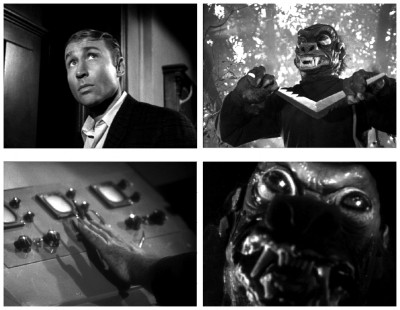 #27 FUN AND GAMES directed by Gerd Oswald from a script by Robert Specht and Joseph Stefano. Ex-boxer and petty criminal Mike Benson (Nick Adams) and divorcee Laura Hanley (Nancy Malone), each emotionally wounded by life, are abducted by an alien called the Senator (Robert Johnson), who represents the citizens of the planet Andera. The Anderans have overcome war, pestilence, avarice and envy, and find that their lives have become quite stagnant. They therefore replace their boredom with a constant supply of ‘fun and games’. Mike and Laura are teleported to an arena planet where they are pitted in mortal combat against two primitive aliens from the Calco galaxy for the entertainment of the jaded audience on Andera. The goal of the tournament is species survival – the home planet of the losing team will be obliterated in a cataclysmic display lasting five years for the further enjoyment of the citizens of Andera. During the combat, Mike and Laura learn to function as a team. The male Calco alien (Bill Hart) kills its mate (Charles McQuarry) to save food, then confronts Mike on a footbridge over a river of lava. Laura kills the creature with its own saw-bladed boomerang and Mike, hanging by his fingertips and weakened by the ordeal, finally falls off the bridge into the lava. Believing Mike to be dead, Laura mourns his passing and praise his efforts in defending the human race from extinction, but Laura is informed by the Senator that since the alien perished first, Mike’s life was spared and they are declared the winners, thus saving Earth. They are both returned to Earth with no memory of the arena planet, free to resume their mundane lives. Fun And Games was another Outer Limits episode that, when assembled, ran short. In this case Joseph Stefano was able to stretch the minimal footage shot by Gerd Oswald in the editing suite. Mike’s frantic search for a place to hide in Laura’s apartment building is seen three times, and many of the shots on the arena planet are seen twice. You’ll also notice when Laura is teleported the second time it is the same footage used for her first trip. The story is very similar to a subsequent Star Trek episode Arena which was, in turn, based on the Fredric Brown short story Arena. Speaking of Star Trek, the Calco alien mask and gloves, made by Projects Unlimited, were reused in the first Star Trek pilot The Cage. This was Nick Adams first brush with science fiction. Following an appearance on Voyage To The Bottom Of The Sea in 1964, he went to England to co-star with Boris Karloff in Die Monster Die! (1965), then left for Japan to star in Frankenstein Conquers the World (1965), Invasion Of The Astro-Monster (1965) and The Killing Bottle (1967). Returning to America, Adams made one more science fiction film entitled Mission Mars (1968) shortly before he was found dead in his apartment, the victim of an accidental overdose.
#27 FUN AND GAMES directed by Gerd Oswald from a script by Robert Specht and Joseph Stefano. Ex-boxer and petty criminal Mike Benson (Nick Adams) and divorcee Laura Hanley (Nancy Malone), each emotionally wounded by life, are abducted by an alien called the Senator (Robert Johnson), who represents the citizens of the planet Andera. The Anderans have overcome war, pestilence, avarice and envy, and find that their lives have become quite stagnant. They therefore replace their boredom with a constant supply of ‘fun and games’. Mike and Laura are teleported to an arena planet where they are pitted in mortal combat against two primitive aliens from the Calco galaxy for the entertainment of the jaded audience on Andera. The goal of the tournament is species survival – the home planet of the losing team will be obliterated in a cataclysmic display lasting five years for the further enjoyment of the citizens of Andera. During the combat, Mike and Laura learn to function as a team. The male Calco alien (Bill Hart) kills its mate (Charles McQuarry) to save food, then confronts Mike on a footbridge over a river of lava. Laura kills the creature with its own saw-bladed boomerang and Mike, hanging by his fingertips and weakened by the ordeal, finally falls off the bridge into the lava. Believing Mike to be dead, Laura mourns his passing and praise his efforts in defending the human race from extinction, but Laura is informed by the Senator that since the alien perished first, Mike’s life was spared and they are declared the winners, thus saving Earth. They are both returned to Earth with no memory of the arena planet, free to resume their mundane lives. Fun And Games was another Outer Limits episode that, when assembled, ran short. In this case Joseph Stefano was able to stretch the minimal footage shot by Gerd Oswald in the editing suite. Mike’s frantic search for a place to hide in Laura’s apartment building is seen three times, and many of the shots on the arena planet are seen twice. You’ll also notice when Laura is teleported the second time it is the same footage used for her first trip. The story is very similar to a subsequent Star Trek episode Arena which was, in turn, based on the Fredric Brown short story Arena. Speaking of Star Trek, the Calco alien mask and gloves, made by Projects Unlimited, were reused in the first Star Trek pilot The Cage. This was Nick Adams first brush with science fiction. Following an appearance on Voyage To The Bottom Of The Sea in 1964, he went to England to co-star with Boris Karloff in Die Monster Die! (1965), then left for Japan to star in Frankenstein Conquers the World (1965), Invasion Of The Astro-Monster (1965) and The Killing Bottle (1967). Returning to America, Adams made one more science fiction film entitled Mission Mars (1968) shortly before he was found dead in his apartment, the victim of an accidental overdose.
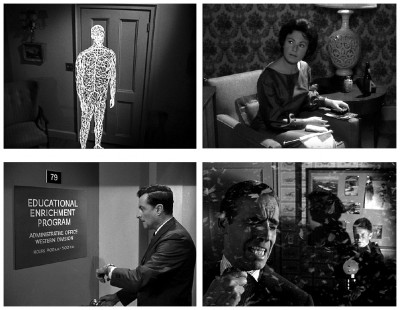 #28 THE SPECIAL ONE directed by Gerd Oswald from a script by Oliver Crawford. Roy Benjamin (Macdonald Carey) and his wife Agnes (Marion Ross) are delighted but puzzled when they meet Mister Zeno (Richard Ney), a government educator sent to tutor their gifted son Kenny (Flip Mark) as part of an Educational Enrichment program. Roy becomes worried when he discovers that Kenny is learning things that are not accepted by earthly science, including a device given to Kenny by Zeno that can control weather patterns. When Roy finds out that the government’s Educational Enrichment program knows nothing about Zeno, he confronts the educator, only to discover that he is an alien, re-educating children in a plot to take over the world. Kenny, who now possesses super-human knowledge and mental powers, has seemingly become loyal to the alien. It is revealed in the last act that Kenny was always aware of Zeno’s evil intentions and decided to feign loyalty in order to thwart his plans. Rendering the alien powerless by using the weather machine, Kenny removes the essential element from the atmosphere that enables Zeno to survive on Earth, forcing the alien to return to his homeworld of Xenon and foiling the alien’s plans of conquest. The introduction to this episode is one of the most thrilling of the series, and the teleportation effect is very effective indeed, despite an obviously small budget. There isn’t much to dislike about this episode: Fine acting, exceptional writing and a story that keeps you on edge, making this definitely one to watch. There is one little problem with the story: it’s made quite clear from the very beginning that Zeno is evil. In retrospect I have no doubt it would have worked better if this was revealed later in the story in order to add to the suspense. Nevertheless, this is one of the best episodes of the series. There are many similarities between The Special One and the Frederik Pohl story Many Happy Returns, in which an alien known only as Mister White persuades an Earth boy to build a gadget that accidentally electrocutes the boy’s father. The alien telepathically communicates instructions to the boy, who is reluctant to be candid with his family.
#28 THE SPECIAL ONE directed by Gerd Oswald from a script by Oliver Crawford. Roy Benjamin (Macdonald Carey) and his wife Agnes (Marion Ross) are delighted but puzzled when they meet Mister Zeno (Richard Ney), a government educator sent to tutor their gifted son Kenny (Flip Mark) as part of an Educational Enrichment program. Roy becomes worried when he discovers that Kenny is learning things that are not accepted by earthly science, including a device given to Kenny by Zeno that can control weather patterns. When Roy finds out that the government’s Educational Enrichment program knows nothing about Zeno, he confronts the educator, only to discover that he is an alien, re-educating children in a plot to take over the world. Kenny, who now possesses super-human knowledge and mental powers, has seemingly become loyal to the alien. It is revealed in the last act that Kenny was always aware of Zeno’s evil intentions and decided to feign loyalty in order to thwart his plans. Rendering the alien powerless by using the weather machine, Kenny removes the essential element from the atmosphere that enables Zeno to survive on Earth, forcing the alien to return to his homeworld of Xenon and foiling the alien’s plans of conquest. The introduction to this episode is one of the most thrilling of the series, and the teleportation effect is very effective indeed, despite an obviously small budget. There isn’t much to dislike about this episode: Fine acting, exceptional writing and a story that keeps you on edge, making this definitely one to watch. There is one little problem with the story: it’s made quite clear from the very beginning that Zeno is evil. In retrospect I have no doubt it would have worked better if this was revealed later in the story in order to add to the suspense. Nevertheless, this is one of the best episodes of the series. There are many similarities between The Special One and the Frederik Pohl story Many Happy Returns, in which an alien known only as Mister White persuades an Earth boy to build a gadget that accidentally electrocutes the boy’s father. The alien telepathically communicates instructions to the boy, who is reluctant to be candid with his family.
 #29 A FEASIBILITY STUDY directed by Byron Haskin from a script by Joseph Stefano. The inhabitants of a six-block suburban area are abducted one night by an alien probe, teleporting the entire neighbourhood to another planet called Luminos. The intention of the Luminoids is to study the feasibility of enslaving the entire human race to perform manual labour on their planet, since Luminoids themselves suffer from a genetic disease that condemns them to become immobile as they age. But the aliens must overcome humanity’s own susceptibility to the disease and mankind’s resistance to slavery. The abductees soon realise that if they survive the humid climate and avoid infection, the immobile Luminoids will abduct Earth’s remaining population and condemn them all to enslavement. The abductees decide to sacrifice themselves for the sake of mankind by voluntarily contracting the disease, thus driving the Luminoids’ feasibility study to failure and forcing them to give up on their goal. This is one of the better episodes of The Outer Limits and it seems to have it all: excellent writing, top-notch photography, lots of originality and some exceptional guest actors, in particular Sam Wanamaker, David Opatashu and Joyce Van Patten, who help to make this one better since they are all terribly good at their job. How the humans handle the unusual situation makes this a great story and quite poignant, and the last act in particular might just make you shed a tear or two. Exceptional.
#29 A FEASIBILITY STUDY directed by Byron Haskin from a script by Joseph Stefano. The inhabitants of a six-block suburban area are abducted one night by an alien probe, teleporting the entire neighbourhood to another planet called Luminos. The intention of the Luminoids is to study the feasibility of enslaving the entire human race to perform manual labour on their planet, since Luminoids themselves suffer from a genetic disease that condemns them to become immobile as they age. But the aliens must overcome humanity’s own susceptibility to the disease and mankind’s resistance to slavery. The abductees soon realise that if they survive the humid climate and avoid infection, the immobile Luminoids will abduct Earth’s remaining population and condemn them all to enslavement. The abductees decide to sacrifice themselves for the sake of mankind by voluntarily contracting the disease, thus driving the Luminoids’ feasibility study to failure and forcing them to give up on their goal. This is one of the better episodes of The Outer Limits and it seems to have it all: excellent writing, top-notch photography, lots of originality and some exceptional guest actors, in particular Sam Wanamaker, David Opatashu and Joyce Van Patten, who help to make this one better since they are all terribly good at their job. How the humans handle the unusual situation makes this a great story and quite poignant, and the last act in particular might just make you shed a tear or two. Exceptional.
 Thanks goes to Wikipedia for certain information, and a big thanks to David J. Schow and Jeffrey Frentzen, authors of the definitive tome The Outer Limits Official Companion (Ace SF 1986), one of the first best television episode guide books ever to be published. If you have any interest in the early formative days of American television, this volume should definitely be near the top of your list. It’s at this point I’ll ask you to please join me next week when I burst your blood vessels with another terror-filled excursion to the dark side of Hollywood for…Horror News! Toodles!
Thanks goes to Wikipedia for certain information, and a big thanks to David J. Schow and Jeffrey Frentzen, authors of the definitive tome The Outer Limits Official Companion (Ace SF 1986), one of the first best television episode guide books ever to be published. If you have any interest in the early formative days of American television, this volume should definitely be near the top of your list. It’s at this point I’ll ask you to please join me next week when I burst your blood vessels with another terror-filled excursion to the dark side of Hollywood for…Horror News! Toodles!
 Horror News | HNN Official Site | Horror Movies,Trailers, Reviews
Horror News | HNN Official Site | Horror Movies,Trailers, Reviews
